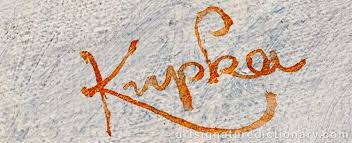Frantisek Kupka
1871-1957
Any questions?
contact@mr-expert.com
Do you own a work by Frantisek Kupka and would you like to know more about its value? Our Experts will carry out a free appraisal of your painting, to provide you with an estimate of the market price, then assist you to sell at the best price.
Status, price and estimation of the artist Frantisek Kupka
Price of a painting by the artist: 1,200 – 2,200,000 €.
Price of a drawing by the artist: 570 – 120,000 €.
Estimation of a print by the artist: 150 – 23,100 €.
If you would like to have a work by Frantisek Kupka appraised, our experts will take care of everything.
A precocious talent
Kupka was born in 1871 in a small town in the Czech Republic. An artist of precocious talent, he entered the Academy of Fine Arts in 1889 to study historical and religious painting, and two years later joined the highly esteemed Vienna Academy. His allegorical paintings were already successful and enabled him to obtain commissions from the aristocracy. At the same time, his interest in science and philosophy led him to take an interest in theosophy by joining the painter and community leader, Karl Wilhelm Dieffenbach.
Breaking away from realism
He then moved to Paris in order to get rid of this academic painting. There he adopted the open-air one for a brighter light and decided, on Mucha’s advice, to support himself by making caricatures for satirical newspapers, being himself in agreement with the workers’ opinion of the time. Inspired by the Viennese Secession (The Song of Songs, 1905) Kupka moves closer to the avant-garde currents of his time. The artist was increasingly dissatisfied with realist painting, wishing to be able to represent “conceptions, its syntheses and agreements. (The Yellow Scale, 1907).
The artist even appeared to take the lead in some avant-gardes, such as when he uses a cinematic method to represent movement (woman picking flowers, 1908-1910), as the Futurists would later do.
Omnipresence of movement
In fact, Kupka can no longer be satisfied with realistic modes of representation in painting. He writes in the notes of Creation in the Plastic Arts that realism is not capable of representing sensations. His work is a theory of perception in that it is a vibration of kinesthetic sensitivity, moving, relative to the sensations experienced by the body and the senses. He also believes that in order to represent something, we must represent the movement of thought that is established from our perceptions. This movement would be the common point of all sensations.
According to him, realism in representation does not in any way present the natural movement of the “vital mechanics” of nature. His paintings between 1911 and 1914 constitute his great organic cycle. “A work by art must be a complex whole, an organism endowed with its own specific qualities of existence, living its own life and on its own account. »
After 1926 and his synthesis work Four Stories of Black and White, Kupka’s works borrowed two different voices. That of the machinist theme, representing the industrial world and the notion of speed that it implies. The second is the one that most of us know: the radical simplification of his compositions, in the greatest abstraction (abstract painting 1930-1932). In these works, abstraction is used to analyse the conditions of vision.
Somewhat forgotten, Kupka’s work was rediscovered in 1975, and even more so in 1989, to finally reach us today as one of the most important collections of the 20th century.
Recognising Kupka’s signature
Like many artists, Kupka did not sign all of his works. However, you will find below an example of a signature in order to give you a first idea. Variations of this signature exist: do not hesitate to contact one of our experts to authenticate a signature in a formal way.

Appraising and selling a painting by Kupka
If you own a painting or any other sculpture by Kupka, ask for a free estimate via our online form.
You will then be contacted by a member of our team of experts and auctioneers to give you an independent view of the market price of your painting. In the event of a sale, our specialists will also advise you on the various options available to sell your work at the best price.